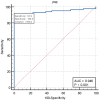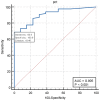Evaluation of Presepsin for Early Diagnosis of Sepsis in the Emergency Department
- PMID: 40217929
- PMCID: PMC11989492
- DOI: 10.3390/jcm14072480
Evaluation of Presepsin for Early Diagnosis of Sepsis in the Emergency Department
Abstract
Background: to date, there are no specific markers available for diagnosing sepsis. Diagnosis is, indeed, mainly determined by clinical suspicion and the evaluation of the patient's overall condition. This evaluation involves assessing various inflammatory markers, such as C-reactive protein (CRP) and procalcitonin (PCT), along with markers of tissue hypoxia, such as serum lactate. Additionally, it includes scores that account for complete blood count (CBC), organ function markers, and the patient's vital parameters, including SOFA, qSOFA, SIRS, and NEWS. Over the years, various potential biomarkers have been studied; among these presepsin appears to offer some significant advantages. Objective: Presepsin, which is the N-terminal fragment of the soluble component of CD14, is primarily elevated in infectious conditions. Its levels rise much earlier in the context of infection compared to currently used biomarkers. As a result, Presepsin shows promise for the early identification of septic patients and could aid in prognostic assessment, allowing clinicians to prioritize care for critically ill individuals. Methods: this study aims to evaluate the role of serum presepsin in the early diagnosis of sepsis in patients who present to the emergency room with a clinical suspicion of sepsis. The secondary objectives include comparing the diagnostic performance of presepsin with traditional biomarkers currently used for sepsis diagnosis and assessing its utility as a prognostic biomarker for mortality risk stratification, in comparison with validated severity prediction scores. Result: Presepsin had valuable diagnostic utility for sepsis (AUC 0.946, p < 0.001) comparable to PCT (AUC 0.905, p < 0.001). Conclusions: the combination of Presepsin, PCT, and EWS yielded the highest diagnostic accuracy for sepsis.
Keywords: ED; molecular biomarkers; presepsin; score and sepsis; sepsis.
Conflict of interest statement
The authors declare no conflicts of interest.
Figures






References
-
- Svendsen M., Steindal S.A., Hamilton Larsen M., Trygg Solberg M. Comparison of the systematic Inflammatory response syndrome and the quick sequential organ failure assessment for prognostic accuracy in detecting sepsis in the emergency department: A systematic review. Int. Emerg. Nurs. 2023;66:101242. doi: 10.1016/j.ienj.2022.101242. - DOI - PubMed
-
- Laih C.-Y., Hsiao P.-J., Wang Y.-D., Lee S.W., Huang C.-P., Chen W.-C., Yang C.-R., Wu H.-C., Chang C.-H., Lai C.-M. PD35-03 QSOFA (quick sequential organ failure assessment score) and sofa scores are valuable tools to predict postoperative sepsis resulting from ureteroscopic lithotripsy (URSL) J. Urol. 2018;199:e721–e722. doi: 10.1016/j.juro.2018.02.1714. - DOI
LinkOut - more resources
Full Text Sources
Research Materials
Miscellaneous

